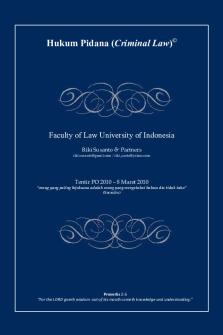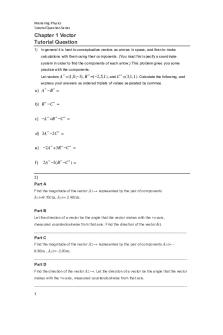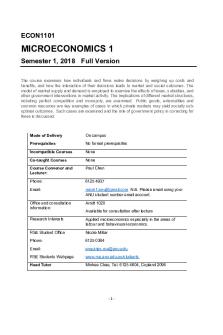KEY Exam2 1311 F10 v A - full version of F10 exam, questions are randomized for different version, keys PDF

| Title | KEY Exam2 1311 F10 v A - full version of F10 exam, questions are randomized for different version, keys |
|---|---|
| Course | General Chemistry for Engineers |
| Institution | The University of Texas at Dallas |
| Pages | 10 |
| File Size | 254.9 KB |
| File Type | |
| Total Downloads | 1 |
| Total Views | 148 |
Summary
full version of F10 exam, questions are randomized for different version, keys included...
Description
Exam 2 1311 F10 Key
version A
1. Predict the ideal bond angles in GeCl4 . A. 120° B. 90° C. < 90° D. 109.5° E. 180° ____________________________________________________________________________________________________________
2. The formula for magnesium sulfite is: A. MgSO3 B. MnS C. MgS D. MgSO4 E. MnSO3 ____________________________________________________________________________________________________________
3. Valence bond theory predicts that iodine will use _____ hybrid orbitals in ICl2 -. A. sp3d2 B. None of these choices is correct. C. sp3d D. sp2 E. sp3 ____________________________________________________________________________________________________________
4. What is the molecular geometry (shape) of NOCl ?
A. B. C. D. E.
trigonal planar trigonal pyramidal linear tetrahedral bent
____________________________________________________________________________________________________________
5. In which of these pairs of atoms would the bond be the most polar? A. C C B. N C C. C Cl D. C H E. O C ____________________________________________________________________________________________________________
6. Which of these atoms is the most electronegative? A. As B. Cs C. Li D. Ge E. P ____________________________________________________________________________________________________________
7. Which of the following molecules has a net dipole moment (i.e. is polar)? A. KrF2 B. CCl4 C. CO2 D. BeCl2 E. SF2 ____________________________________________________________________________________________________________
8. Predict the actual bond angles in SF3 + . A. exactly 120° B. between 109.5° and 120° C. less than 90° D. between 90° and 109.5° E. more than 120° ____________________________________________________________________________________________________________
9. Predict the electron domain geometry around the central atom in BCl3 A. B. C. D. E.
trigonal bipyramidal trigonal planar trigonal pyramidal octahedral tetrahedral
____________________________________________________________________________________________________________
10. Complete this sentence: The PCl5 molecule has A. nonpolar bonds, and is a nonpolar molecule. B. nonpolar bonds, but is a polar molecule. C. polar bonds, but is a nonpolar molecule. D. polar bonds, and is a polar molecule. ____________________________________________________________________________________________________________
11. The number of resonance structures for the best Lewis structure of sulfur dioxide is: A. 4 B. there is only one structure (i.e. no resonance) C. 3 D. 2 ____________________________________________________________________________________________________________
12. Which response includes all the molecules below that do not follow the octet rule for the central atom? (1) H2S (2) BCl3 (3) PH3 (4) SF4 A. PH3 and SF4 B. BCl3 and PH3 C. BCl3 and SF4 D. All four Lewis structures obey the octet rule for the central atom E. H2S and BCl3 ____________________________________________________________________________________________________________
13. Which is the correct formula for copper(II) phosphate? A. Cu(PO3)2 B. Cu(PO4)2 C. Cu2PO3 D. Cu3(PO4)2 E. Cu2PO4 ____________________________________________________________________________________________________________
14. Predict the electron domain geometry around iodine, the central atom in the ion ICl2 ¯ : A. trigonal bipyramidal B. octahedral C. bent D. tetrahedral E. trigonal planar ____________________________________________________________________________________________________________
15. Indicate the type of hybrid orbitals used by the central atom in SF6. A. sp3d2 B. sp2 C. sp3 D. sp3d E. sp ____________________________________________________________________________________________________________
16. What is the name of PCl3? A. trichlorophosphide B. phosphorus trichlorate C. phosphorus trichloride D. phosphorus chloride E. phosphoric chloride ____________________________________________________________________________________________________________
17. Select the best Lewis structure for NOCl, a reactive material used as an ionizing solvent.
A. a B. b C. c D. d E. None of these choices is correct. ____________________________________________________________________________________________________________
18. What is the molecular geometry (shape) of ClF2 ¯ ? A. T-shaped B. tetrahedral C. bent D. see-saw E. linear ____________________________________________________________________________________________________________
19. What is the name of HClO4 ? A. hydrochlorate acid B. chlorous acid C. chloric acid D. hydrochloric acid E. perchloric acid ____________________________________________________________________________________________________________
20. Select the compound with the smallest magnitude lattice energy. A. NaCl(s) B. SrO(s) C. CsBr(s) D. KBr(s) E. CaO(s) ____________________________________________________________________________________________________________
21. The number of sigma bonds in the molecule below is: A. 16 B. 10 C. 19 D. 14 E. 12 ____________________________________________________________________________________________________________
22. What is the name for Al(NO3)3•2H2O ? A. aluminum(III) trinitrate dihydrate B. aluminum trinitrate dihydrate C. aluminum nitrate dihydrate D. aluminum nitrate hydrate E. aluminum nitrate ____________________________________________________________________________________________________________
23. Phosphoryl iodide is used in the preparation of organophosphorus derivatives and phosphate esters. Select the Lewis structure for POI3 which minimizes formal charges.
A.
B.
C.
D.
E.
____________________________________________________________________________________________________________
24. What is the formula for the binary compound formed by calcium and selenium? A. CaSe3 B. CaSe2 C. Ca3Se D. CaSe E. Ca2Se ____________________________________________________________________________________________________________
25. In the best Lewis structure of the iodate ion, IO3 -, the formal charge on the central iodine atom is: A. 0 B. -2 C. +2 D. -1 E. +1 ____________________________________________________________________________________________________________
26. Which of these compounds is most likely to be ionic? A. GaAs B. NO2 C. H2O D. SrBr2 E. CBr4 ____________________________________________________________________________________________________________
27. The average Te–O bond order in TeO4 2– is: A. 1.0 B. 1.5 C. 1.33 D. 1.66 E. 2.0 ____________________________________________________________________________________________________________
28. The compound, NaH2PO4, is present in many baking powders. What is its name? A. sodium hydrophosphate B. sodium dihydride phosphate C. sodium hydrogen phosphate D. sodium biphosphate E. sodium dihydrogen phosphate ____________________________________________________________________________________________________________
29. What is the name of the compound formed when H2S gas is dissolved in water? A. hydrosulfuric acid B. sulfuric acid C. hydrosulfurous acid D. sulfidic acid E. sulfurous acid ____________________________________________________________________________________________________________
30. Which one of the following Lewis structures is definitely incorrect? A. NO2
B. SO2
C. BeCl2
D. CO32¯
E. CH4
____________________________________________________________________________________________________________
31. Lithium forms compounds which are used in dry cells and storage batteries and in high-temperature lubricants. It has two naturally occurring isotopes, 6Li (atomic mass = 6.015121 amu) and 7Li (atomic mass = 7.016003 amu). Lithium has an average atomic mass of 6.9409 amu. What is the percent abundance of lithium6? A. 7.503% B. 46.16% C. 6.080% D. 92.50% E. 86.66% ____________________________________________________________________________________________________________
32. Which of these choices is the best Lewis structure for ozone, O3? A. B. C. D. E. ____________________________________________________________________________________________________________
33. Select the best Lewis structure for nitrogen trifluoride, NF3.
A. B. C. D. E.
a b c d e
____________________________________________________________________________________________________________
34. The ideal value for the bond angle indicated by "a" in the illustration below is: A. B. C. D. E.
180° 109.5° 120° 90° 270°
____________________________________________________________________________________________________________
35. The F S A. 180° B. 120° C. 90° and 180° D. 90° and 120° E. 109.5°
F bond angles in SF6 are:
____________________________________________________________________________________________________________
36. Which of the following is the empirical formula for C4H10O2 ? A. C8H20O4 B. C2H5O C. CH2.5O0.5 D. C2H5 E. C4H10O2 ____________________________________________________________________________________________________________
37. Select the Lewis structure for XeO2F2 which correctly minimizes formal charges.
A. a B. b C. c D. d E. e
____________________________________________________________________________________________________________
38. Diiodine pentaoxide is used as an oxidizing agent that converts carbon monoxide to carbon dioxide. What is its chemical formula? A. I2O5 B. 2IO5 C. (IO5)2 D. I5O2 E. IO5 ____________________________________________________________________________________________________________
39. What is the molecular geometry (shape) of BrF4 ¯ ? A. square pyramidal B. octahedral C. tetrahedral D. see-saw E. square planar ____________________________________________________________________________________________________________...
Similar Free PDFs

WING ET1 F10 Klausur
- 14 Pages

F10 Form Explanation
- 1 Pages

Hukum Pidana Full Version
- 52 Pages

Full Tutorial - pdf version
- 91 Pages

Course Outline - Full Version
- 10 Pages

Ans to Ex. 1(a) - full version
- 8 Pages

Ans to Ex. 1(a) - full version
- 8 Pages

Black Black SASH FULL Version
- 3 Pages
Popular Institutions
- Tinajero National High School - Annex
- Politeknik Caltex Riau
- Yokohama City University
- SGT University
- University of Al-Qadisiyah
- Divine Word College of Vigan
- Techniek College Rotterdam
- Universidade de Santiago
- Universiti Teknologi MARA Cawangan Johor Kampus Pasir Gudang
- Poltekkes Kemenkes Yogyakarta
- Baguio City National High School
- Colegio san marcos
- preparatoria uno
- Centro de Bachillerato Tecnológico Industrial y de Servicios No. 107
- Dalian Maritime University
- Quang Trung Secondary School
- Colegio Tecnológico en Informática
- Corporación Regional de Educación Superior
- Grupo CEDVA
- Dar Al Uloom University
- Centro de Estudios Preuniversitarios de la Universidad Nacional de Ingeniería
- 上智大学
- Aakash International School, Nuna Majara
- San Felipe Neri Catholic School
- Kang Chiao International School - New Taipei City
- Misamis Occidental National High School
- Institución Educativa Escuela Normal Juan Ladrilleros
- Kolehiyo ng Pantukan
- Batanes State College
- Instituto Continental
- Sekolah Menengah Kejuruan Kesehatan Kaltara (Tarakan)
- Colegio de La Inmaculada Concepcion - Cebu







